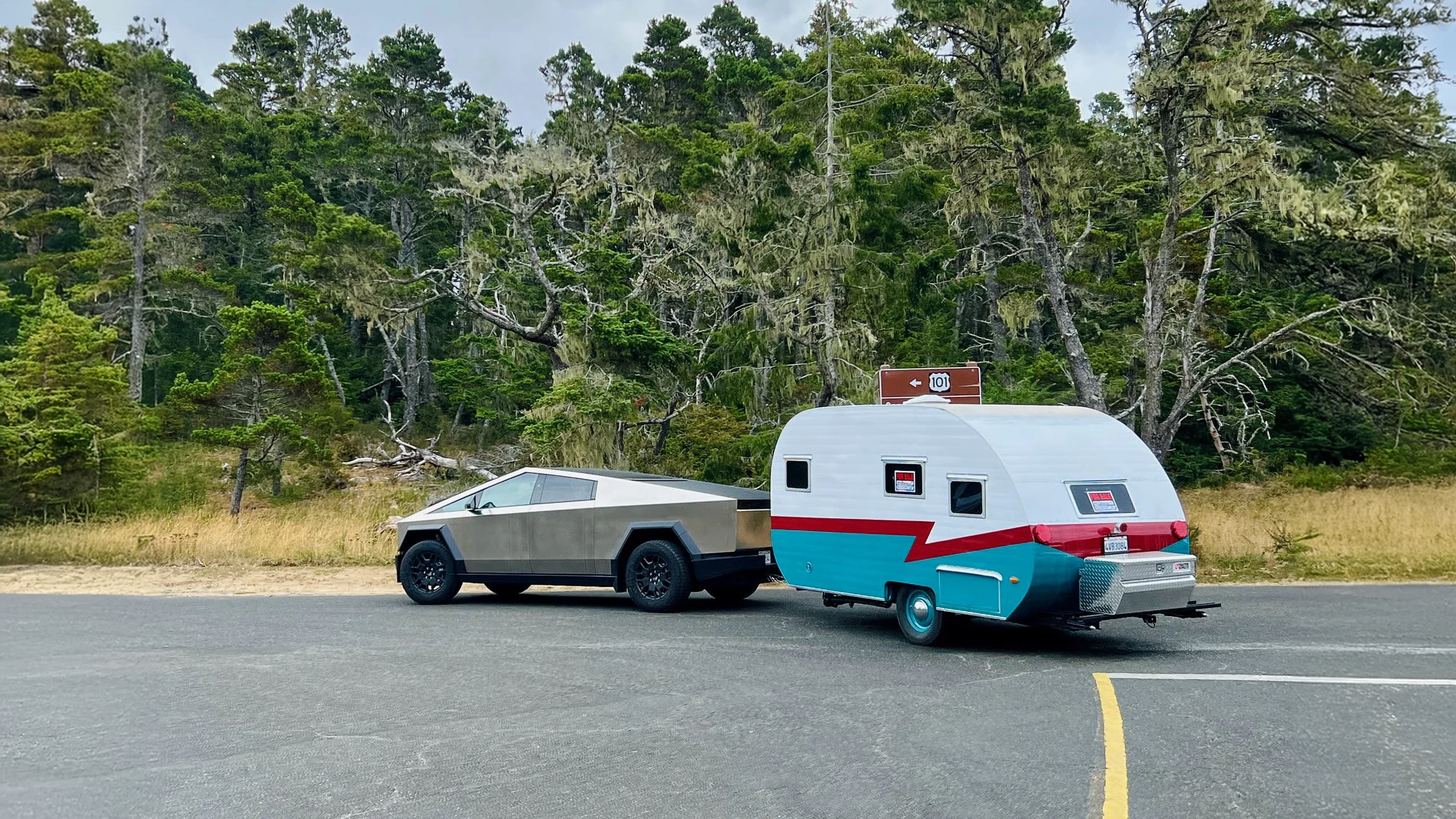
Well now..what have we here?
I could not have found a better visual description of the metamodern of I had asked some robot to conjure an image like this. (This image is of human made. It came to me from my friend Dawn’s camera (phone?) who I imagine just knew I’d make hay out of it. ❤️)
There it is. The Tesla Cybertruck. The beacon of cyberpunk aesthetics and apocalyptic preparedness, paired unexpectedly and ironically with a midcentury-style camper trailer painted in vibrant, patriotic red, white, and, um…teal? This visual juxtaposition is just too much to resist. We have the embodiment of a kind of rich, contingent complexity — the blending themes of impending doom with nostalgic optimism.
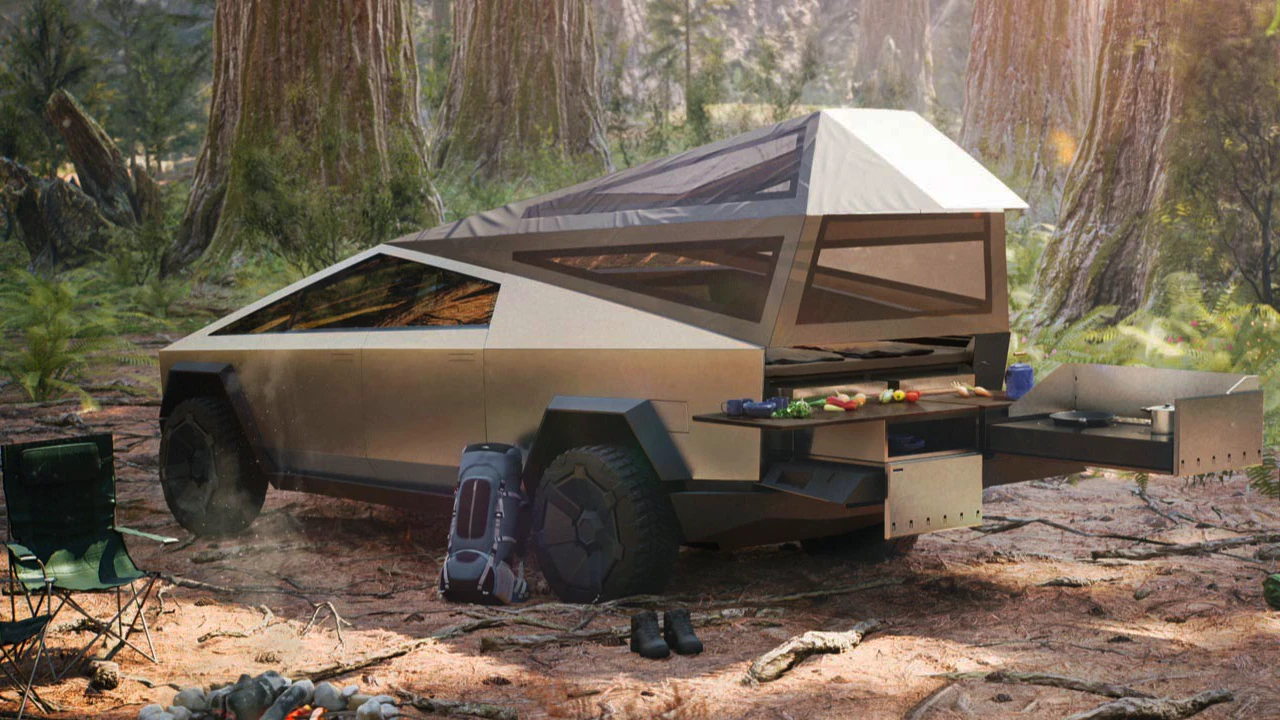
The Cybertruck of course is built on the aesthetics of cyberpunk. It has the necessary sharp angles and rugged design that index towards stealth, hoodie-hacker malfeasance, boys-will-be-boys antics (fjording rivers and rolling over rocks for no particularly utilitarian reason), and surveillence avoidance. At the same time it represents readiness for urgent kinetic ram-rod exploits. The Cybertruck evokes a future fraught with uncertainty and conflict and its own ability to keep its occupants safe from that uncertainty (even if it very likely would not provide much protection, if any, as Elon himself demonstrated during that one, you know..demo). It symbolizes a world where survival and resilience are paramount, reflecting the cyberpunk fascination with technology amidst chaos, unrest, battle, collapse, attack, repel.. This vehicle stands as a testament to our contemporary anxieties about technological advancement and its potential consequences. It’s cyberpunk design aesthetics — not the Mad Max bricolage of vintage hot rods and cheap gas era model muscle cars tethered to Burning Man / S&M / DIY / Steampunk / Cirque du Soleil material culture vibes. The Cybertruck feels like a design aesthetic that is decidedly out of place in 2024.
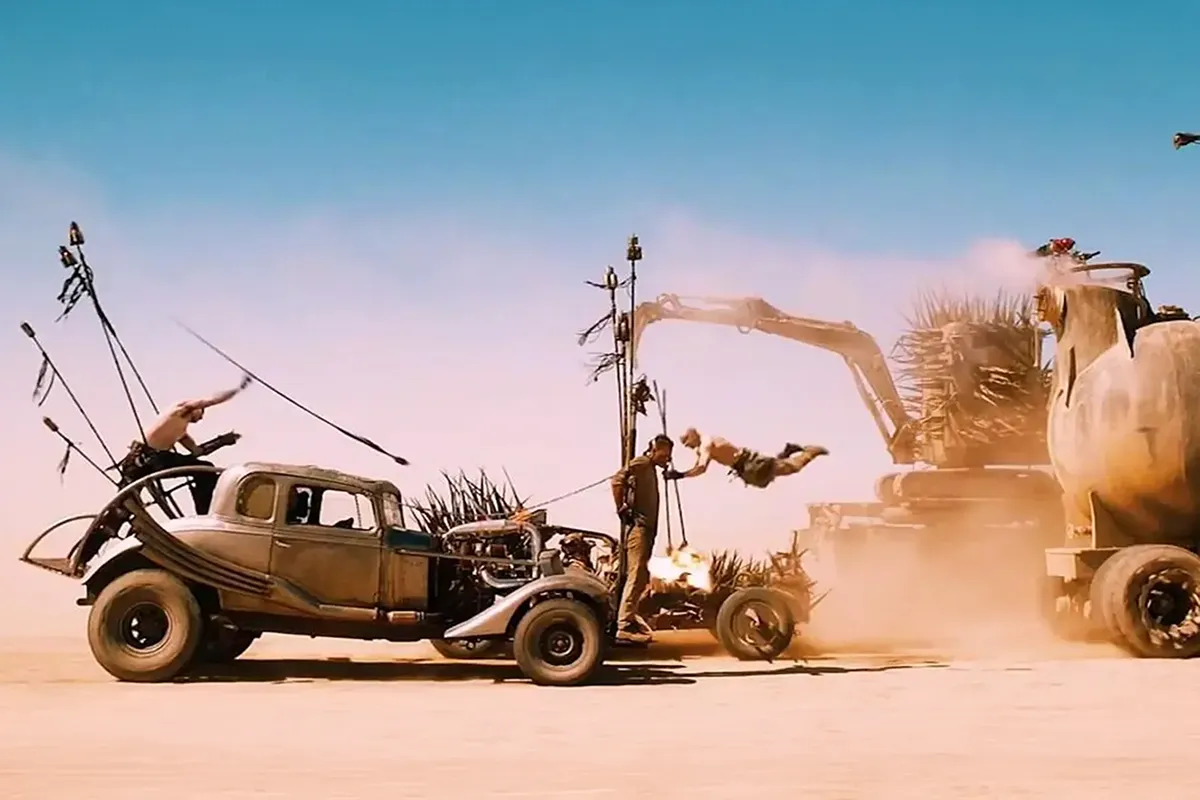
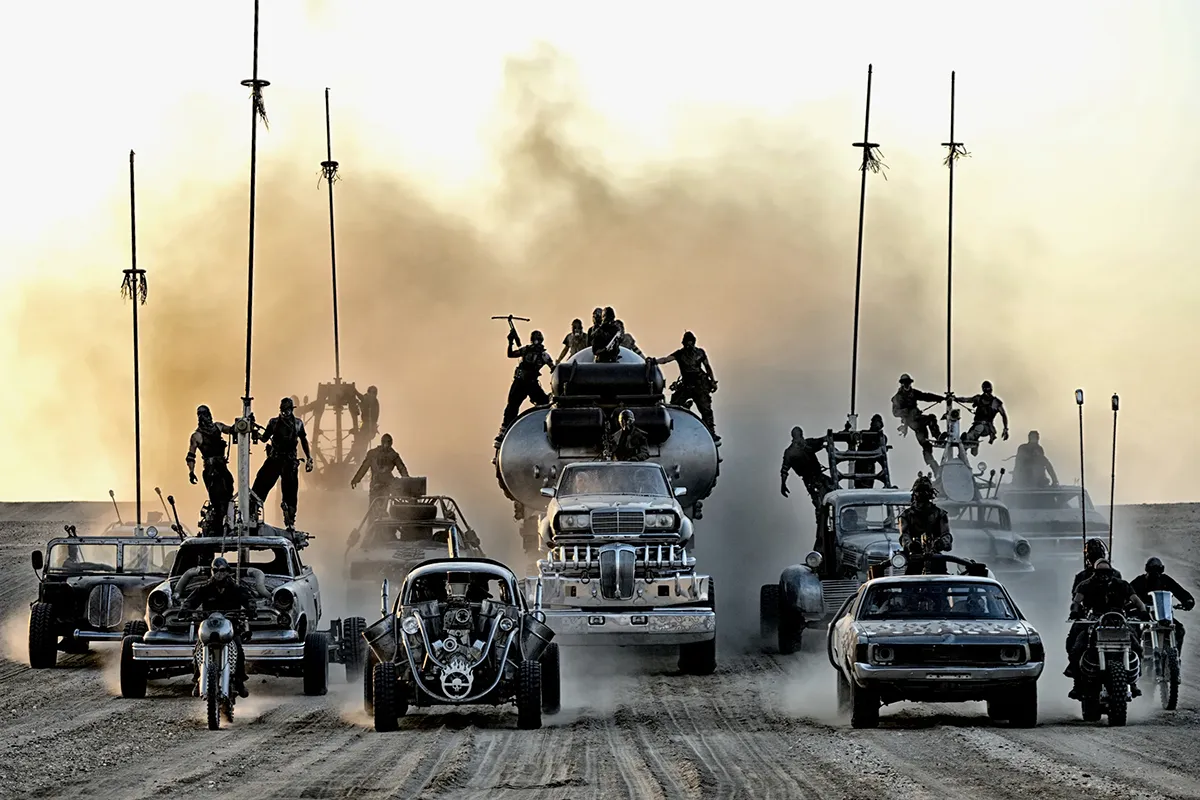

But wait. What’s this? A classic / now-retro trailer camper? What’s it doing there?
That’s the camper that has come from past idyllic visions of the 1950s and 1960s in the United States, a time characterized by a hopeful optimism, patriotic pride, and the simple joys of family *car camping adventures. It’s “My Three Sons” and “Leave It To Beaver” and “Brady Bunch” and the simple utility of a plain-old fashioned fishing rod and perhaps a Winchester rifle or boys-first-shotgun mail ordered from Sears and used for nothing so much more complicated/fraught than hunting quail — flushed from the tall grass by Chester, the family’s trusted Boykin Spaniel. Its classic design and patriotic colors evoke a sense of Americana, and a longing for the perceived simplicity and stability of the post-World War II era.
Yet, this 50s/60s nostalgic optimism was not without its dark, looming, shadow. Those same decades were marked by the looming threat of nuclear annihilation, as the Eisenhower/Kennedy/Nikon/Stalin/Khrushchev/Brezhnev Cold War tensions between the USA and the Soviet Union cast an anxious and dark pall over the era’s outward cheerfulness.
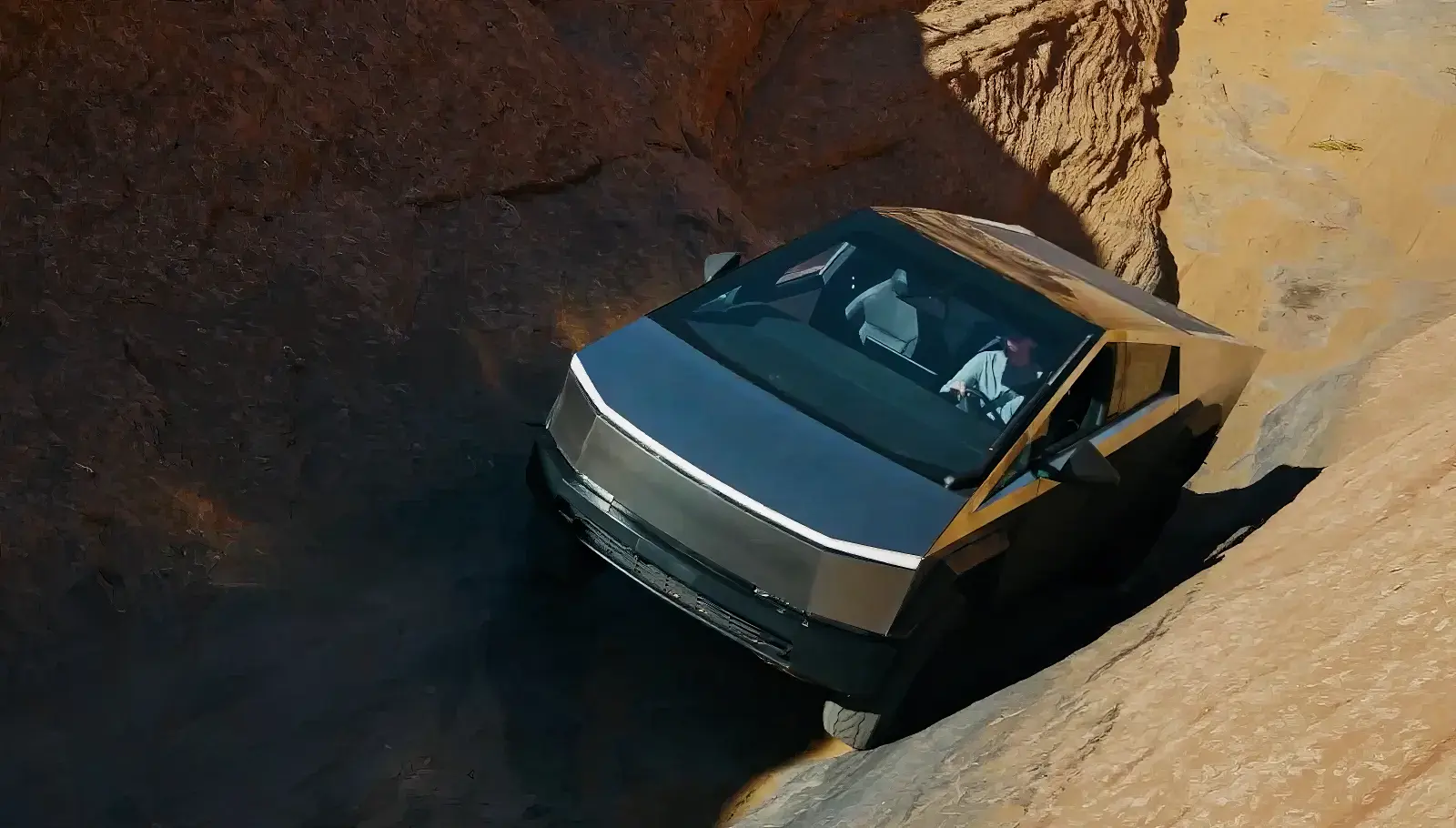
The camper hitched to the Cybertruck? To its future? These two together index towards this underlying anxiety. The Cybertruck is the darkness that lies beneath the post-World War II optimism in the US — or in this case, the Cybertruck, situated in front of the camper, is the dark future of the camper lifestyle, anticipating the cyberpunk future. It is as if the Cybertruck has come from the apocalypse of the Camper’s nightmare future. Together these two arranged this way remind us that even in those times of great hope, the “Greatest Generation” — enjoying the fruits of its own battles lakeside with its 2.5 kids and can of beer — was one that lived with fears of future conflict and catastrophe.
There’s an oscillation here in the image, one between these seemingly opposing meanings of kinds of survival. We’ve got these two wheeled-vehicles, artifacts from two different worlds, each semantically representing to different kinds of survival. The one indexes survival in conflict, fire, communication network failures, falling satellite debris, societal collapse (but not, evidently, the collapse of a power grid). The other evokes comfort-level survival — more comfy than sleeping in the rough with an itchy horse blanket.
The Cybertruck and the camper together illustrate how our present is continually shaped by both our aspirations and our apprehensions. They serve as probes or experiments within the Design Fiction framework, helping us navigate the intricate landscape of contemporary life. By bringing together symbols of apocalypse and hope, this image invites us to reflect on how our ideals and realities intersect, revealing the multifaceted nature of progress and the enduring human spirit that seeks to find balance amidst contradiction.
I’m possibly seeing some metamodern going on here. I could be wrong, but down in the Rabbit Hole you continually try to make sense of the abstract by tracing it in the exemplars that maybe exhibit its characteristics, so let’s try this on for size 👇🏽
In the metamodern sensibility, we recognize that our journey towards some North Star future is neither purely dystopian nor nostalgically idealistic. Instead, it is a rich tapestry woven from the threads of past experiences and future possibilities, urging us to engage critically and creatively with the world as it is and as it could be. The camper and cybertruck co-existing in time, despite coming from decidely different moments, and co-existing in space — I mean..there they are together, living in material as if some quantum entanglement output them from a nozzle somewhere and plopped them there suddenly. Of course, in the consciousness of whoever owns these two, together, simultaneously is likely a rich story of that entanglement. (I would love to hear it, truly. What are they believing, aspiring towards, recollecting, vibing..)
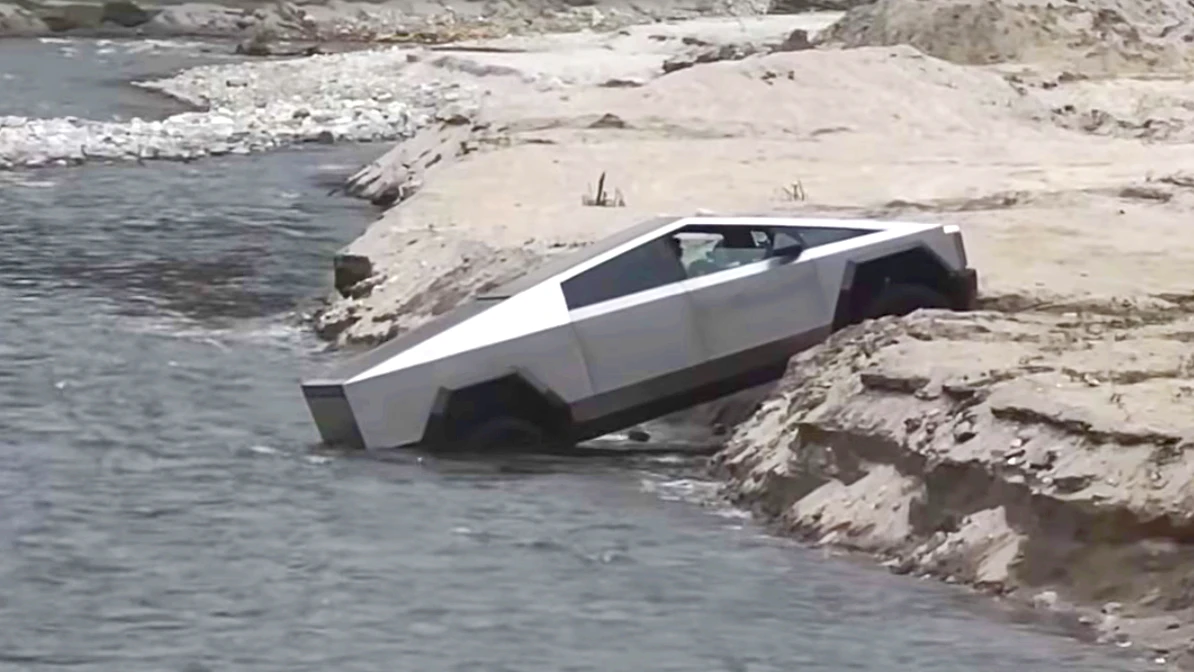
Remember the post on Mark Fisher’s Hauntology a few days ago? Remember how hauntology refers to the ways in which the present is haunted by the “lost futures” of the past? Hauntology is a bit spooky insofar as it makes these visions of what the future could have been, but never came to pass feel lost or displaced and irretrivable.
The Cybertruck symbolizes the future vehicle one would need should the apocalyptic vision of the cyberpunk future come to pass. The cyberpunk future is the ‘woops..I hit the red button..’ future. The Cybertruck is the vehicle all adolescents imagine they’ll have should WOPR not get the lesson learned from playing the world’s simplest game, Tic-Tac-Toe. That future is the future shaped by anxiety, survivalism, and the techno-aesthetics of system error, master alarm, societal collapse. The Cybertruck represents a world where technology has evolved in response to fears of disaster rather than the pursuit of the kind of habitable futures represented by the fun and playful adventure of that camper to which it is inextricably hitched. The Cybertruck is a product of a future where resilience and ruggedness are prized, yet it is also a future that feels more like a willful, even excited giving-up of obtaining a more habitable future.
The Cybertruck and the camper are not just physically hitched; they are hauntologically entangled. The camper, a relic of a hopeful past, is literally being dragged into the future by the Cybertruck. This hitching together is like pulling forward past dreams into a quite ironic future: ‘I want to have my cake and eat it, too.’ You can almost see the moment of pulling the camper through a wasteland and finding a momentary oasis where the travails of daily Mad Max battles-to-survive are forgotten for an evening of camping, fireside marshmallow roasting, earnestly prepared Negroni’s, and an early bedtime.
This displacement embodies the core of Fisher’s hauntology: the idea that we are living in a time when the future seems increasingly foreclosed, and we are left haunted by the lost futures of the past. The Cybertruck and the camper together here? They’re like a visual narrative of this haunting in which the present is constantly overshadowed by the futures we were promised but that can never arrive.
Ultimately, this image is a haunting reflection on how the futures we now imagine are inextricably linked to the futures we’ve lost. The Cybertruck and the camper remind us that our current reality is a space where the past and future are constantly in dialogue, where our present is haunted by the futures that could have been and by the futures that may yet come to pass.
Makes sense?